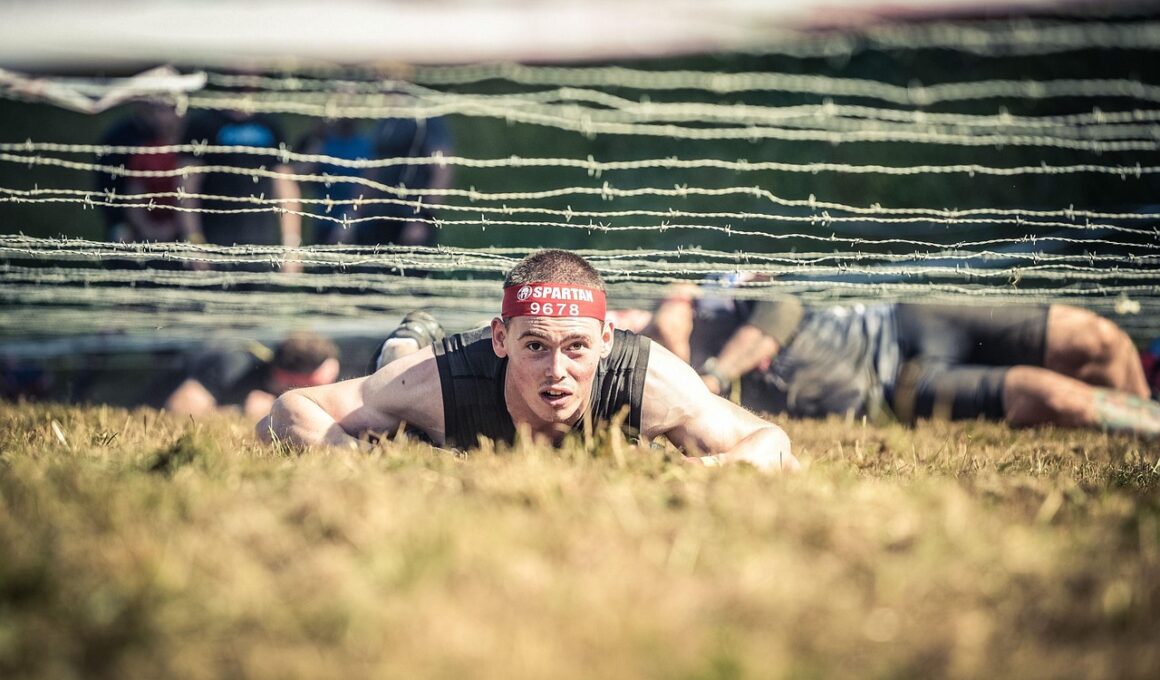Advanced Trail Running Techniques for OCR Competitors
Obstacle Course Racing (OCR) athletes require more than just grit; they must possess specific techniques to navigate trails effectively. One of the foremost methods involves building solid endurance through gradual elevation. Incorporating hill sprints into your routine aids in developing leg strength and cardiovascular capacity. Techniques like tempo runs help maintain speed over longer distances, which is crucial during competitions. Regularly practicing various terrains prepares participants for race day. Adapting to rocky, muddy, or steep trails during your training mitigates unexpected challenges during an event. Combining mobility workouts enhances flexibility, crucial for avoiding injuries while running on rugged trails. Techniques such as dynamic stretches and yoga allow OCR athletes to improve range of motion while strengthening vital muscle groups. Additionally, focusing on form is essential; proper foot positioning and posture can drastically reduce fatigue. Athletes should prioritize core stability, as it enhances balance and strengthens the overall physique. Lastly, incorporating speed drills into practice sessions boosts agility. Remember, the more diverse your training, the better prepared you will be for the unique demands of obstacle course racing.
Hydration and Nutrition for Optimal Performance
Fueling your body effectively is vital in OCR training. Hydration levels should be carefully monitored, as dehydration can hinder performance. Consuming an adequate amount of water before and during training sessions helps sustain energy levels. Additionally, electrolytes play a significant role; they assist in muscle function and prevent cramping during prolonged exertion. Athletes are encouraged to develop a personalized nutrition plan that supports intense training regimens. Integrating whole foods rich in carbs, proteins, and healthy fats can sustain energy and facilitate recovery. Pre-training snacks, like bananas or energy bars, are excellent for providing immediate fuel. Post-workout meals should focus on replenishing lost nutrients, with lean proteins aiding in muscle repair. It’s essential to experiment with food and hydration strategies during training. Knowing what works best for your body will yield optimal results on race day. Supplements such as BCAAs or protein powders can be considered to enhance overall recovery strategies. Engaging a sports nutritionist to fine-tune your dietary approach can provide useful insights into improving their training routines and performances.
Incorporating Speed and Agility Workouts
Adding speed and agility training to your routine enhances OCR performance considerably. By focusing on quick footwork exercises, athletes can develop necessary reflexes and responsiveness on diverse terrains. Ladder drills improve coordination, while cone drills enhance lateral movement essential during obstacle navigation. Regular sprint workouts help build explosive speed, allowing you to tackle obstacles more efficiently. Practicing short bursts of high-intensity sprints followed by periods of rest mirrors the demands of OCR events, which involve transitioning between running and overcoming various challenges quickly. Plyometric training can boost power through explosive movements, benefiting racing starts and jumps. Engaging in activities such as box jumps or bounding can develop the leg strength required for high-intensity obstacles. Additionally, interval training incorporates periods of intense effort followed by slower-paced recovery rounds. This technique boosts aerobic capacity while enhancing speed over time. Maintaining consistency in these workouts is key; regular exposure builds muscle memory, ensuring quick adaptations during competitions. Don’t forget to include rest days to recover fully, as overtraining increases the risk of injuries that could hamper athletic progress during training.
Strength Training for Trail Runners
For OCR competitors, strength training is critical. It helps in developing the muscle endurance and power necessary to complete obstacles efficiently. Focusing on compound movements, such as squats and deadlifts, targets multiple muscle groups simultaneously, enhancing overall strength. Incorporating exercises like lunges can also develop leg muscles while improving balance. Strength training targeting core stability is essential; exercises like planks and Russian twists increase core engagement, vital for maintaining form over challenging terrains. Including kettlebell swings or battle rope sessions can boost stamina while simultaneously enhancing muscular endurance. Regular strength sessions should be integrated into your weekly training plan, occurring about two to three times weekly. It’s also crucial to allow recovery time between strength training sessions to prevent overload and injuries. Balancing strength workouts with trail runs helps ensure optimal performance without compromising endurance. To maximize the efficacy of strength training, consider consulting with a professional trainer who specializes in OCR-specific needs. They can develop a customized program that aligns with your goals, paving the way for improved performance during races.
Effective Recovery Techniques
Recovery strategies play a pivotal role in ensuring peak performance during training. Implementing techniques such as foam rolling aids in muscle recovery by alleviating muscle soreness following intense workouts. Regular stretching enhances flexibility, reducing the risk of injuries while maintaining a full range of motion. Active recovery days, where low-intensity activities like cycling or walking are incorporated, promote blood circulation without imposing too much stress. Adequate sleep should never be underestimated; it’s essential for physical and mental recovery, ensuring athletes are refreshed and prepared for subsequent workouts. Engaging in mindfulness or yoga practices can greatly enhance mental resilience as well. Nutrition should also focus on recovery, with protein intake offering essential building blocks for muscle repair. Don’t overlook hydration; replenishing fluids post-training helps restore optimal function. Using cold therapy, such as ice baths, may alleviate soreness and reduce inflammation. Additionally, techniques like massage therapy can be invaluable in promoting relaxation and healing. Regularly reviewing and refining your recovery approaches can lead to enhanced performance, sustaining the energy and readiness needed for competitive OCR events.
Building Mental Toughness for OCR
Mental preparation is as crucial as physical training for OCR competitors. Cultivating mental toughness enables athletes to push through challenging moments during races. Incorporating visualization techniques helps create a mental blueprint of successful race execution. Athletes are encouraged to envision themselves overcoming obstacles and achieving personal bests. Positive self-talk is another powerful tool; affirmations can transform negative thoughts into empowering beliefs. Practicing mindfulness enhances focus, helping manage anxiety in high-pressure situations. Setting realistic goals fosters a sense of accomplishment, driving motivation and encouraging consistent progress. Developing a strong support network also aids in building mental resilience; sharing experiences with fellow OCR athletes cultivates a sense of community. Regularly challenging oneself through different terrains and difficulties helps to enhance adaptability, further cementing mental strength. Furthermore, reviewing past race performances allows participants to identify areas for improvement while celebrating successes. When faced with overwhelming pressures during competition, remember that embracing discomfort is part of the growth process. Ultimately, mental toughness will shape the strategies an athlete employs, allowing for an effective and enriching OCR experience.
Conclusion: Comprehensive Training Approach
In summary, advanced trail running techniques integrate various training domains tailored specifically for OCR competitors. Mastering endurance, strength, speed, agility, and mental resilience empowers athletes to exceed limits and conquer course challenges. Consistent practice focused on diverse terrains sharpens skills crucial for race day success. Proper nutrition and hydration support robust training regimens, while effective recovery practices ensure athletes remain at their peak. Balancing all aspects of training cultivates a holistic approach, enabling participants to tackle any obstacle encountered. Adopting these advanced techniques will undoubtedly provide a competitive edge essential to outperforming others in OCR events. Additionally, leveraging community support within organizations fosteres motivation and dedication, enhancing the training journey. Remember, the road to success requires commitment; however, the benefits reaped far exceed the efforts exerted. So gear up and embrace the exhilarating journey that OCR training presents. Engage in near-daily practice, reflect on progress, and maintain a resilient mindset. Ultimately, your journey toward becoming a formidable OCR competitor lies in your hands; every step taken brings you closer to achieving your racing goals.
Your future OCR victory starts here!


